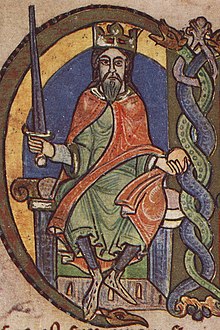
Back Dauid I Scotta Cyning ANG ديفيد الأول ملك إسكتلندا Arabic ديفيد الاول ملك اسكتلندا ARZ David I d'Escocia AST Давід I Byelorussian Дейвид I Bulgarian David I d'Escòcia Catalan David I. Skotský Czech Dafydd I, brenin yr Alban Welsh David 1. af Skotland Danish
| David I | |||||
|---|---|---|---|---|---|
 | |||||
| King of Alba (Scotland) | |||||
| Reign | 23 April 1124 – 24 May 1153 | ||||
| Coronation | Scone, April or May 1124 | ||||
| Predecessor | Alexander I | ||||
| Successor | Malcolm IV | ||||
| Prince of the Cumbrians | |||||
| Reign | 1113–1124 | ||||
| Born | c. 1084 | ||||
| Died | 24 May 1153 (aged 68–69) Carlisle | ||||
| Burial | |||||
| Spouse | Maud, Countess of Huntingdon | ||||
| Issue |
| ||||
| |||||
| House | Dunkeld | ||||
| Father | Malcolm III of Scotland | ||||
| Mother | Margaret of Wessex | ||||
David I or Dauíd mac Maíl Choluim (Modern Gaelic: Daibhidh I mac [Mhaoil] Chaluim;[1] c. 1084 – 24 May 1153) was a 12th century ruler and saint who was Prince of the Cumbrians from 1113 to 1124 and later King of Scotland from 1124 to 1153. The youngest son of King Malcolm III and Queen Margaret, David spent most of his childhood in Scotland but was exiled to England temporarily in 1093. Perhaps after 1100, he became a dependent at the court of King Henry I of England, by whom he was influenced.
When David's brother Alexander I died in 1124, David chose, with the backing of Henry I, to take the Kingdom of Alba (Scotland) for himself. He was forced to engage in warfare against his rival and nephew, Máel Coluim mac Alaxandair. Subduing the latter seems to have taken David ten years, a struggle that involved the destruction of Óengus, Mormaer of Moray. David's victory allowed expansion of control over more distant regions theoretically part of his Kingdom. After the death of his former patron Henry I, David supported the claims of Henry's daughter and his own niece, Empress Matilda, to the throne of England. In the process, he came into conflict with King Stephen and was able to expand his power in northern England, despite his defeat at the Battle of the Standard in 1138. David I is a saint of the Catholic Church, with his feast day celebrated on 24 May.[2][3]
The term "Davidian Revolution" is used by many scholars to summarise the changes that took place in Scotland during his reign. These included his foundation of burghs and regional markets, implementation of the ideals of Gregorian Reform, foundation of monasteries, Normanisation of the Scottish government, and the introduction of feudalism through immigrant Anglo-Norman, Norman and Flemish knights.
- ^ Scottish Gaelic has effectively dropped the Máel in Máel Coluim (meaning "tonsured devotee of Columba") so that the name is just Colum or Calum (meaning "Columba"); the name was borrowed into non-Gaelic languages before this change occurred.
- ^ Thurston & Attwater, Butler's Lives of the Saints, pp. 383–384.
- ^ "Dawid". DEON.pl (in Polish). Retrieved 10 December 2021.